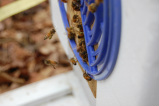|
7/5/2023 Nurturing Nature's Pollinators: The Fascinating Life Cycle of Common Eastern BumblebeesRead NowIn the vibrant tapestry of nature, bumblebees play an indispensable role as pollinators, ensuring the continued growth and reproduction of countless plant species. Their fuzzy bodies, adorned with vibrant black and yellow stripes, are a familiar sight in gardens, fields, and meadows. These gentle insects, often mistaken for their honeybee cousins, are vital contributors to agricultural productivity and ecosystem health.
The Common Eastern Bumblebee (Bombus impatiens) is one of the most widespread and recognizable bumblebee species in North America. Their annual life cycle, a fascinating dance of reproduction, growth, and development, is a testament to the resilience and adaptability of these remarkable creatures. Spring Awakening: A Queen's Quest for a Nest As the chill of winter recedes and the warmth of spring invigorates the earth, a remarkable transformation unfolds. Overwintering Common Eastern Bumblebee queens, having spent the long months in hibernation, emerge from their earthen burrows, their bodies fueled by reserves of stored energy. Driven by an innate instinct, these solitary queens embark on a critical mission: to find a suitable nesting site. Their search takes them through diverse landscapes, from dense forests to open fields, seeking out sheltered locations that offer protection from the elements and predators. Establishing a Home: The Nest Takes Shape Once a suitable site is identified, the queen sets about establishing her new home. With meticulous care, she gathers soft materials, such as moss, grass, and animal fur, to construct a nest. This rudimentary structure, often nestled within abandoned rodent burrows or beneath fallen logs, will serve as the foundation for her growing colony. From Egg to Adult: The Metamorphosis of a Bumble Bee Within the confines of the nest, the queen begins her royal duties, laying eggs that will give rise to the next generation of bumblebees. These eggs, initially small and white, undergo a remarkable transformation known as metamorphosis. After a period of incubation, the eggs hatch into larvae, resembling tiny white grubs. These voracious feeders consume a diet of pollen and nectar provided by the queen, their bodies growing rapidly as they progress through several larval stages. As the larvae mature, they spin silken cocoons around themselves, entering a pupal stage. Within these protective coverings, their bodies undergo a dramatic transformation, shedding their larval form and emerging as adult bumblebees. A Colony in Bloom: The Hive Takes Shape With the emergence of the first worker bees, the bumblebee colony begins to take shape. These female bees, smaller than the queen, assume the primary responsibilities of nest maintenance, foraging for food, and caring for the developing larvae. As the colony expands, the division of labor becomes increasingly intricate. Worker bees diligently tend to the nest, cleaning, repairing, and defending it from intruders. Meanwhile, other workers venture out into the surrounding environment, their fuzzy bodies buzzing from flower to flower, collecting nectar and pollen to sustain the colony. The Fall of Autumn: A New Generation Emerges As summer wanes and autumn approaches, the bumblebee colony reaches its peak size. The queen's focus shifts from egg-laying to nurturing the next generation of reproductive individuals, male drones and future queens. These newly emerged males depart from the nest, their primary purpose to mate with queens from other colonies. After fulfilling their reproductive role, the males perish, their lives dedicated to ensuring the perpetuation of their species. The future queens, on the other hand, embark on a crucial quest for survival. They accumulate fat reserves, preparing for hibernation and the challenge of establishing new colonies the following spring. With the onset of winter, the colony's activity dwindles. The worker bees, their roles fulfilled, gradually die off. The old queen, having spent her energy nurturing the colony, also succumbs to the changing seasons. Only the newly mated queens remain, their bodies bearing the promise of new life. They seek out sheltered locations, burrowing into the earth to enter hibernation, their slumber a prelude to the renewal of the bumblebee cycle. SeaBee Honey: Championing Bumble Bee Conservation Amidst the growing concern over pollinator decline, SeaBee Honey stands as a beacon of hope, dedicated to the conservation of Common Eastern Bumblebees. Through their innovative approach of rescuing and relocating bumblebee hives to local farms, they play a pivotal role in enhancing crop pollination and preserving the delicate balance of nature. By providing safe havens for these remarkable pollinators, SeaBee Honey directly contributes to the sustainability of agriculture and the preservation of biodiversity. Their efforts are a testament to the power of human intervention in safeguarding the natural world and ensuring a future where the buzz of bumblebees continues to fill our fields and gardens.
0 Comments
Leave a Reply. |
Details
SEABEE HONEY BLOGAuthorA beekeeper in New Hampshire [email protected] Archives
December 2023
Categories
All
|

 RSS Feed
RSS Feed